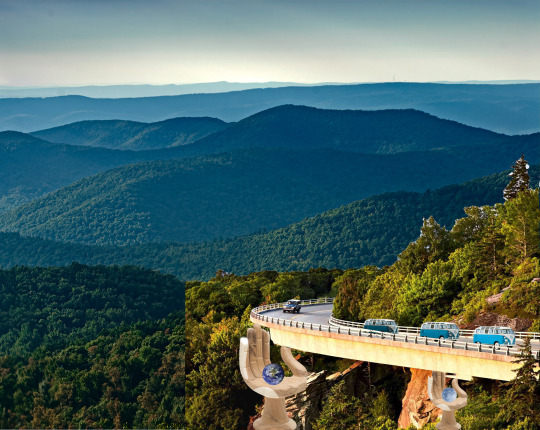#KaraZhang
Photo

Photo: www.gabrieleardemagni.com model: @karazhang agency: @luxxmodelsofficial @annaterzoli mua: @irene_otekpere location: Milano (presso New Era World Studio Milano)
0 notes
Text
blogpost #13
I enjoyed reading Derek Jarmon’s On Seeing Red – the stream of consciousness writing style was captivating. I found the piece to be engaging for its breadth of ideas mentioned, keeping some connections when transitioning, while also continuing to pique interest from the novelty of the writing. I appreciated how Jarmon developed the personal side throughout the piece, starting with ideas and writings of others before beginning to add stories of red from his own life. Furthermore, I appreciated Jarmon’s use of history and mythology to illustrate his ideas on red. While reading the text, I found myself imagining times that I have experienced and seen the scenes described. In my mind, I saw the red sunsets Jarmon mentioned, and agreed with the metaphors that he writes about the color red. At times, he asks the reader to imagine an idea without its characteristic red, or to replace something with an artificial red; I found such exercises to be vivid and visceral.
I enjoyed Rebecca Solnit’s The Blue of Distance even more – I was strongly drawn to the poetic language and imagery that was so densely packed in the piece. I liked that Solnit made descriptions of images from art/representations of the real world as well as occurrences from the real world. A memory from her own life was interspersed throughout the chapter as well, bringing a nice narrative to the piece. I found myself responding emotionally to the piece, especially the descriptions of scenery and the significance of distance in human lives and relationships. I liked the main idea of blue being the color of distance, and how both the color and distance play with aspects of the human experience. I was certainly imagining scenes from my memories as well as relationships that reflect Solnit’s claims.
0 notes
Text
blogpost #11
The MFA’s Life Magazine and the Power of Photography was a captivating exhibit that included a breadth of work from Life Magazine photographers, while contrasting it with several modern photographic artworks. One of the first things I noticed in myself upon entering the exhibit was how much more I have grown to appreciate photographs in museums; previously, I did not have a critical eye to explore the depth of an image and think of the creation process. I was also reminded of the importance that analog, B&W photography held in media during the period when Life was active. I appreciate the exhibit’s coverage of the teamwork process behind each photographic project: the journalist, scouts, and level of embeddedness that came with each assignment. Finally, I thought the background for the creation of Life and its early mission were valiant and admirable; to bring the world to many people’s eyes with truthfulness and depth was a lofty and noble goal.
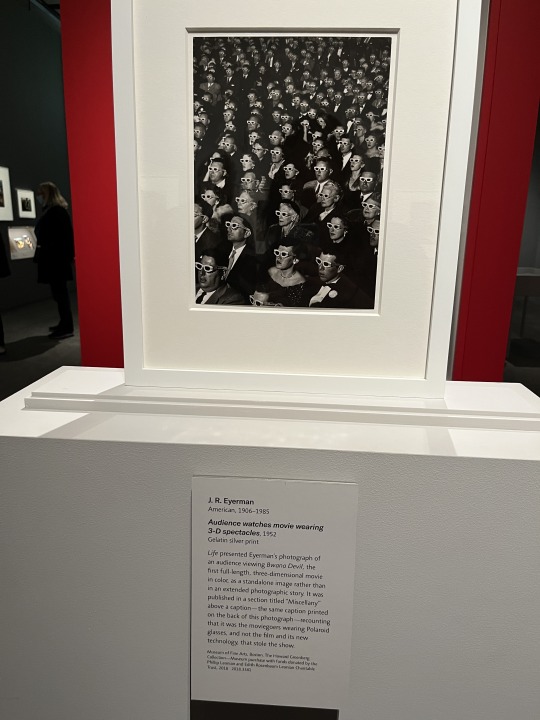
This image by J.R. Eyerman instantly drew my attention when I saw it because it is a familiar image; it has become popularized on the internet today and used as a base for collages and edits. I am impressed by the accompanying story, which was that Eyerman was originally tasked with documenting the new 3D movie technology, but instead turned his camera around to shoot the audience. This shows the eye and talent of such a photographer, to be willing to subvert an assignment to chase what calls to him in subject matter. Lastly, this image is reminiscent of modernity’s ideas of “sheeple,” that many in the world today are not free thinkers but just consume what media is presented to them in the same way as everyone around them. That idea is certainly portrayed in this image, despite the fact that it was taken in 1952.
0 notes
Text
blogpost #10-A
I found the movie Faces Places to be a very quaint and heartwarming documentary of a project and friendship between Agnes Varda and JR. I was instantly drawn to the humorous and honest personality of Agnes; it is clear that she has experienced more in her life than most people have and that she carries her experiences as wisdom as the walks through later life. She has a rich personality and fun ideas for her photography. JR also proved to be an entertaining character, almost a caricature of himself with his sunglasses constantly on.
I found their works within their project to be mostly interesting for the stories and subjects they highlighted moreso than the images created and pasted. While the scale and process was certainly impressive, I did not think all the photographs chosen were necessarily the most artistically novel. One piece that I did particularly enjoy was the photograph of the man Agnes knew pasted on the piece of bunker that had been pushed from a cliff to the beach below. I was struck by JR’s insistence that they go forward with their work despite the incoming tide and knowledge that their image would be gone by the next day. I thought that added an interesting dimension to the project series, as the other works aimed to draw attention in large and somewhat lasting way. The beach bunker piece, however, was only meant to occupy a small place in time and had little audience other than the ocean. Thus, I enjoyed the breath within the work and the portrayals in the film.
0 notes
Text
blogpost #12
I struggled with T. S. Eliot’s Wasteland – I found the passages as they stood individually to be comprehensive but found difficulty in connecting the pieces together into a cohesive work. Aside from the convoluted narrative path that the poem takes, I thought the language was very descriptive and rich. It certainly evoked distinct emotions at different sections. The dialogue and proper nouns offer to make the scene clear, with characters and locations. Futhermore, the scenic descriptions and language choices effectively convey mood throughout the poem, especially depictions of the landscapes and scenes of action. The poem evoked memories in me of similar landscapes I have experienced, though I found the action difficult to understand and relate to.
For my photoshop collage, I used the tools: magnetic lasso, object selection, crop, background eraser, frame, clone stamp, blur, text, eye dropper, paint bucket. I drew inspiration for the composition from a recent visit to San Fransisco and included depicitons/excerpts from activities and scenes I saw.

0 notes
Text
blogpost #10
James Baldwin’s writing is always a treat to read; he speaks with such depth and richness of his relationship with his father around the time of his passing. I appreciated the critical but biased perspective Baldwin spoke about his father with; it felt incredibly real and human to have some air of intrigue but also resentment towards his father. Baldwin’s descriptions didn’t aim to make some thesis about whether his father was good or bad but attempted to show the nuance and the reactive nature of his father’s behavior. The way he made a full character through his stories inspire me to chase humanity and depth of characterization in photography.
Baldwin highlighted the difference in the façade his father displayed to the world, and how that contrasted with the person he was around his family. Furthermore, he emphasized how as his life progressed, his father failed to keep the two separate, as they bled together throughout his life. Another thing I noticed in Baldwin’s writing is how physical appearance and characteristics were related to internal thoughts and feelings of his father. This further reminds me to pursue portrayals in photography that can make those connections between the physical surface and the internal character of a subject. What techniques used in writing can be employed in photography to convey the character of a subject? How much closeness and intimate understanding is required before an accurate portrayal can be made as such?
0 notes
Text
blogpost #9
Selections from Storyteller: The Photographs of Duane Michals, by Linda Benedict-Jones.
Duane Michals is a photographer who became widely known in the 1960s mostly for his work with multiple exposures, text written on his photographs, and series of photographs. Michals’ work is strikingly different from that of other photographers we have studied in this term, as the techniques he employs seem in opposition to what is valued by others. Michals himself contrasted himself explicitly with Henri Cartier-Bresson, who employed the “decisive moment;” Michals called his photographs “anti-decisive moment.” His work involves an intentional process of ideation, planning and setup. I find that his work is thus able to tell stories in a different way, still evoking strong emotion in the viewer and involving complex and flushed out ideas.
Furthermore, Michals draws often from themes in his own personal life, a concept that I also have not seen much from other photographers we studied, who aim to convey things out of other people. In this way, the process that Michals employs feels familiar to me personally in my process, but also is like other visual art mediums. In his time, Michals enjoyed recognition of his work, and for pursuing methods not previously utilized much in photography. The works I below selected spoke to me in a striking personal way, through Michals’ bold writings in accompaniment with his images. I appreciated that he did not shy away from darkness in his thoughts and perspectives, while also having undeniable creativity and artistry.
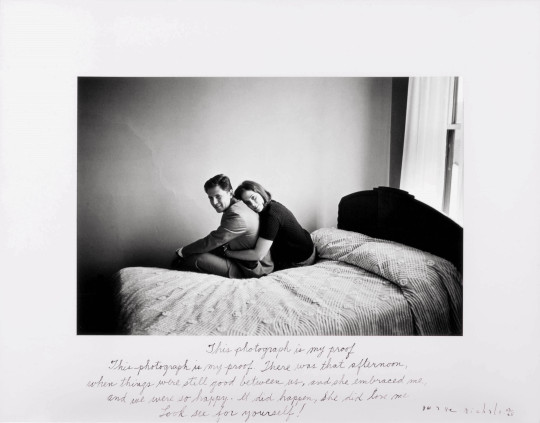
Duane Michals. This Photograph Is My Proof, 1967.

Duane Michals. Alice's Mirror, 1974.

Duane Michals. Spread from The House I Once Called Home, 2003.

Duane Michals. Things Are Queer, 1973.

Duane Michals. The Return of The Prodigal Son, 1991.

Duane Michals. Grandmother and Odette Visit the Park, 1992.

Duane Michals. The Nature of Desire, 1986.
0 notes
Text
blogpost #8
The Magnum Photos Cooperative was formed shortly after the conclusion of World War II, mainly as a response by its founding photographers to the horrors they had witnessed and to guide their work for the coming years. The Cooperative ensured each photographer maintained their artistic independence, owning their work and allowing them to pursue subjects independent of commercial dictates. The organization grew in number and success rapidly; founder Henri Cartier-Bresson was prompted to realign the organization’s members back to the original goal to “bring testimony on our world” and “keep our heads and our lenses above the artificial life.” With such goals as direction, I personally appreciate the Magnum Photo Cooperative’s historical and continued commitment to bringing forth societal awareness via photography.
Cornell Capa was an early member of the Magnum Photos Cooperative, joining the organization after his brother, and cofounder of Magnum, Robert Capa’s death in 1954. Prior to becoming a member of Magnum, Cornell Capa began his photography career as a his brother’s printer in Paris for a year, before moving to New York to be a photographer himself for Life magazine. In 1956, after two years at Magnum, Capa took over the role of President, serving for four years.
In his own words, Cornell Capa distinguished himself from his brother Robert, who had been known as a war photographer since before WWII, describing himself as “a photographer of peace.” In his lifetime, he explored subjects like old age in America, disabled children, religious tradition, and indigenous Latin American cultures. He also had an affinity for politics, photographing John and Robert Kennedy’s campaigns. Capa founded the International Center of Photography in New York City in 1974 and acted as its director.

Cornell Capa | JFK for President. John F. Kennedy and his wife Jackie during a ticker tape parade in Manhattan. New York, USA. 1960. © Cornell Capa © International Center of Photography | Magnum Photos

Cornell Capa | Robert F. Kennedy campaigning for the Senate. Elmira, New York, USA. 1964. © Cornell Capa © International Center of Photography | Magnum Photos

Cornell Capa | Crowd in street under poster of Lenin. Moscow, Russia, 1958. © Cornell Capa © International Center of Photography | Magnum Photos

Cornell Capa | Russian Orthodox nuns and priest. Zagorsk, Russia, 1958. © Cornell Capa © International Center of Photography | Magnum Photos

Cornell Capa | Boys entering chapel at Winchester College. Winchester, UK. 1951. © Cornell Capa © International Center of Photography | Magnum Photos
1 note
·
View note
Text
blogpost #7
Our viewing of The Salt of the Earth evoked an incredibly strong response in me as a viewer, both to the narrative crafted by director Wim Wenders and to Sebastiao Salgado’s works and life stories. I could tell that both the director and photographer did not shy away from portraying the full scope of Salgado’s experiences and work, including the gruesome and grim. I actually found the brutal honesty overwhelming in its intensity – I found myself having to look away from the graphic photographs at times.
I found Salgado a lot more grounded than some of the other photographers we have studied. It did not seem like he was ever gratuitous with his photography of people experiencing the direst tragedies. He strove to connect with subjects beyond his camera, and it was important to him to travel to the heart of humanitarian crises to bring global awareness to them. He always highlighted the humanity and truth of his subjects. Furthermore, I appreciated his immense commitment to each photographic project, immersing himself in the same conditions as those he was documenting and seeing each phenomenon through to completeness. His track record of documenting humanitarian issues demonstrates that he was not just finding these subjects for the photographic value they might have for his work, but that he has a commitment to the broad issue and how he can help.
Wim Wenders was well equipped to direct the documentary on Sebastiao Salgado – as a photographer himself who had been working for many decades, his work displays similar affections as Salgado’s. He similarly pursued large-scale, long timeline photographical projects of unglamorous subjects.

Sebastiao Salgado. Workers under contract to truck owners load trucks with coal, a dirty and exhausting job paid only twenty-two rupees ($1.30) per day. Bihar, India, 1989.

Sebastiao Salgado. Sugar-cutting brigades work in regions and fields where machines are impractical. More than one-third of Cuban production is hand-cut, and workers receive special bonuses. Cuba, 1988.

Wim Wenders. Once, VILLA RUFOLO, RAVELLO, ITALY 1995.
0 notes
Text
blogpost #6
I greatly enjoyed the interviews with both Bruce Davidson and W. Eugene Smith, and found both men to present quite favorably. Both interviewers aim to highlight the shared humanity of these great photographers with the public and the photographer’s subjects. I found Davidson particularly approachable in his answers – not pretentious in his practice but rather meticulous and rigorous. I also appreciated how he described several ways he may go about a project; he might think of the subject and his observations and how through photographing them he might learn more about their story. On the other hand, Davidson mentions how sometimes he needs the story to find him. I appreciate the exercise he mentions of photography starting out of a blank canvas, and that every body of work comes out of a different state of mind. Davidson has dedicated his life to his art, whether that is through long-term immersions with subject matters or in his unrelenting pursuit of a new environment or new shot. I wonder if it can be possible for one to produce such consistently meaningful work as Davidson has done without such full dedication of body and mind?
Arthur Goldsmith’s 1956 interview with W. Eugene Smith was a conversation with an aim to discuss technicalities of lighting, but it also provided insight to Smith’s humanity. I found Smith’s expertise with lighting personally helpful in thinking about how to interact with lighting as a dynamic and essential player in photographs. Specifically, I appreciated how he was willing to introduce artificial lighting to ensure a photograph could more accurately show what the eye saw of a subject, rather than shooting in strictly available light. I also thought his insistence on the responsibility of a photographer to minimize disruption both of a situation while shooting and of a subject under distress was admirable. In general, Smith conveyed his nuance as an artist and human when contrasting himself to garish amateurs. How can beginner photographers, especially in today’s digital age where so much of photography is easily accessible, avoid the pitfalls Smith describes, regarding lighting technicalities and interactive practice with subjects?

Bruce Davidson. Brooklyn Gang - Kathy fixing her hair in a cigarette machine mirror, Coney Island, New York City, USA. 1959.
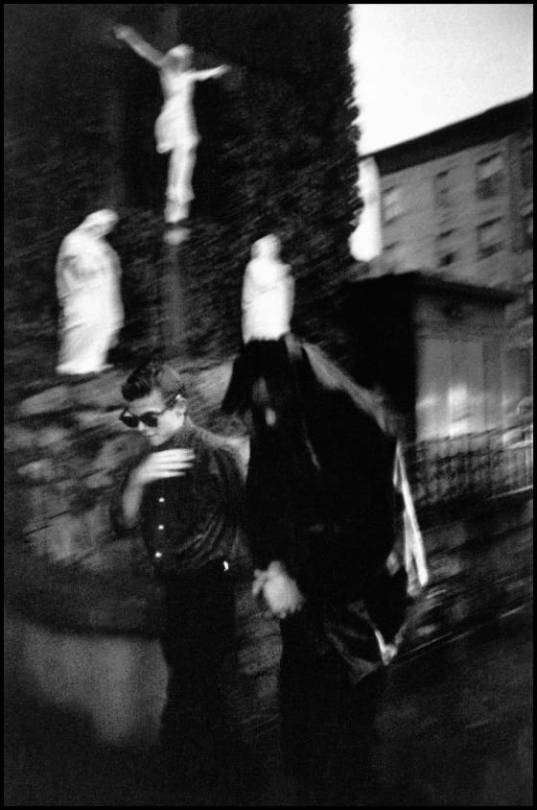
Bruce Davidson. USA. New York City. 1959. Brooklyn Gang. Bengie (L) crossing himself in front of Holy Name Church.

W. Eugene Smith. Spanish Village, Time & Life Pictures.
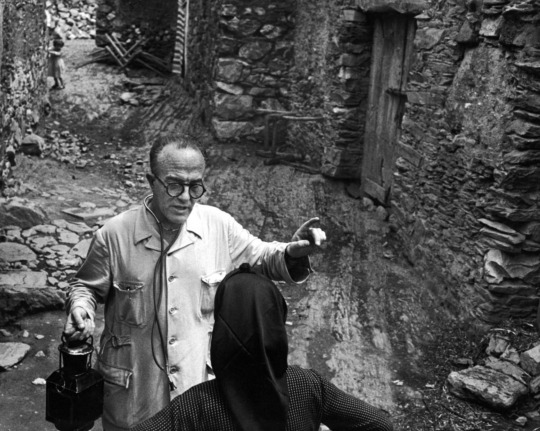
W. Eugene Smith. Spanish Village, Time & Life Pictures.
0 notes
Text
blogpost #5

Bruce Davidson East 100th Street. New York City. USA. 1966.
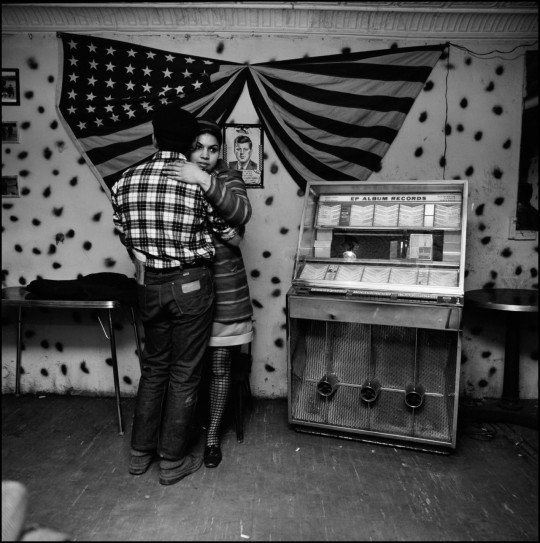
Bruce Davidson East 100th Street. New York City. USA. 1966.
From reading more of Bruce Davidson’s biography, I grew to appreciate even more his work on the East 100th St project. As someone who is struggling to have the courage to engage with many strangers on the street to photograph them, I learned the importance of connecting with subjects and not just swooping in to photograph for my own benefit then leaving. His work is intimate and reveals the comfortability he shared with subjects.

Boogie. From It's All Good, 2006.

Boogie. From It's All Good, 2006.
I appreciate Boogie’s use of aperture to focus on portions of images. I would like to employ similar techniques for highlighting pieces of a subject. Additionally, I was drawn to Boogie’s images for the bold story of how he made a place within a community many would not want to. He doesn’t necessarily glorify the gangs and drugs, but shows them with truth and the range of emotions that the people certainly experience.
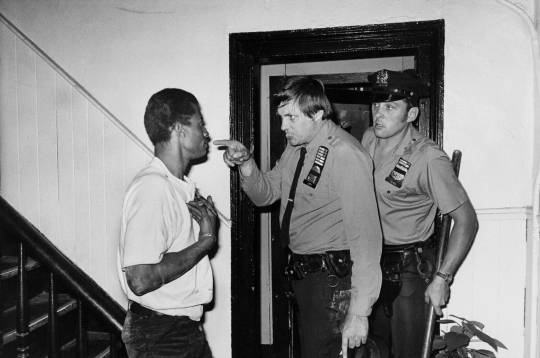
Jill Freedman. From Street Cops, New York City, 1978.

Jill Freedman. From Street Cops, New York City, 1978.
Jill Freedman’s interview portions were very interesting for her opinion about the NYPD. Some understanding must be given that her Street Cops body of work was created in the late 70s, not in the present day climate, but I was still taken aback by her apparent sympathy for the police officers she photographed. I can appreciate the artistry of her photographs and how she did not shy away from capturing everything she could while embedded with the police, but would not agree with her obsession over the subject matter.
0 notes
Text
blogpost #4
Walter Benjamin’s A Short History of Photography presented more of an opinion piece on the early days of photography rather than a more chronological documentation of the field. Granted, the piece was written in 1931, such that the focus of his writing of the 1850s and the few decades thereafter is not as much a skewed perspective as a modern reader might have. Benjamin seems to have a very elevated view of photography and appears a purist on the subject. He makes lengthy comparisons between photography and painting, emphasizing the ways that photography surpasses painting in some contexts. I appreciated the claim that, compared to portrait painting, keeps the identity of the subject even far into the future, and that the subject “does not yield herself entirely into art.” In this, Benjamin highlights that photography can preserve more of the essence of the subject than portrait photography, because the latter would be diluted to just its artistic value rather than its reflection of the subject’s identity with time. However, he qualifies this by stating that photography did not usurp open air landscape painting in the same way as it was not sufficient to capture that essence. Are these claims, that photography has taken the place of portrait painting but not landscape painting, still true today?
The later portion of the text touches on some shortcomings of early photography and its practices. Benjamin mentions how many early photographs include a clearly artificially placed support for the subject to lean or sit on, since the exposure was so long and the subjects had to remain still for long periods of time. Another point that resonated with me was that photography reflects a social urge to “overcome uniqueness by reproducing it.” He explains the desire caused by the invention of photography to possess an object in close proximity. These two trends are particularly relevant today, so it is interesting to see its mention in Benjamin’s work even in 1931. In what ways are these phenomena driven by the same urges today and in the early twentieth century?

August Sander. Young Farmers, ca. 1914.

August Sander. Country Girls, 1925.

August Sander. Rural Bride, 1920-5.

Germaine Krull. French Cancan, 1929/1929.

Germaine Krull. French Cancan, 1929/1929.

David Octavius Hill. Fishwives in St Andrews bait their lines, 1844.

David Octavius Hill. Finlay, deer stalker in the employ of Campbell of Islay, 1845.
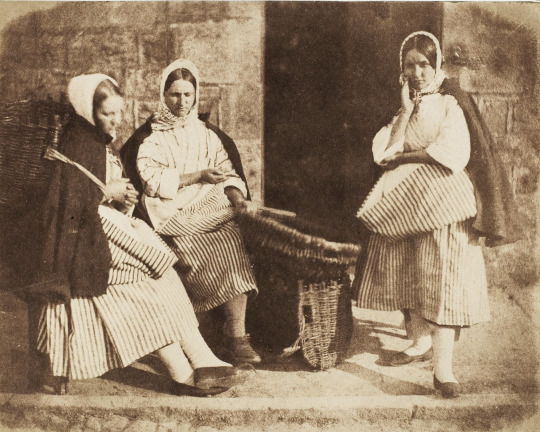
David Octavius Hill. Newhaven fishergirls pose with a creel (between 1843 and 1847).
1 note
·
View note
Text
blogpost #3
Eye Tracking:

William Klein. Dorothea McGowan, Vogue, Paris, 1960.
Contours in yellow, first pass in red, second pass in purple, third pass in blue.

Henri Cartier-Bresson. Torcello in the Venetian Lagoon, Italy, 1953.
Contours in yellow, first pass in blue, second pass in pink, third pass in red.

Robert Frank. [Businessmen conferring aboard the Pennsylvania's Afternoon Congressional (formerly known as the Congressional Limited) commuter train]. The LIFE Magazine Collection, 2005.
Contours in yellow, first pass in blue, second pass in pink, third pass in red.

Garry Winogrand. Los Angeles, 1964.
Contours in yellow, first pass in blue, second pass in pink, third pass in red.
Imagined Photographs:
My partner and I started our exploration walk at my house in the Fenway neighborhood, and walked in a southerly direction towards the Northeastern University campus and neighboring areas. We focused our observations on the architecture of the area and infrastructure.
Image 1: As we approached the Museum of Fine Arts, we found ourselves at a familiar busy intersection. This intersection of two wide streets also contained a T subway line, crosswalks patterned in black and white tile, and large buildings surrounding it. At the corner we stood, we framed a photograph of the building directly opposite us, which was painted with a mural that created the illusion of protruding windows, though there were actually none. In our framing, the top half of the image is dominated by a vibrant blue sky, with a tall steel building on the left edge of the photograph. There are many cars passing near the foreground. The middle of the photo is in shadow from the tall building on the left, while the foreground is highlighted by the midday sun. The cars are less in focus in the image, conveying their movement.
Image 2: We walked through the top part of what is known as the Southwest Corridor, and saw a line of 4 basketball courts back to back in a long line. From our approaching angle, we framed a photograph from close behind the first basketball hoop, which faced away from us, such that the other 7 hoops were closely arranged in a line, though mostly all in view. We want to convey the linearity of this infrastructure. We also framed the image from above our standing height by getting onto a bench to elevate the angle. The shadows from the trees on the left also are present in the image, along with the top quarter of the image of blue sky with clouds.
0 notes
Text
blogpost #2
Susan Sontag stakes a series of bold claims and declarations on photography in "In Plato's Cave." I was struck by the elitism apparent in Sontag's opinions; for example, she seems to denigrate "work that makes virtue of plainness [...] still lifes of the bleaker sort." Personally, I hold an opposing opinion, that there is inherent value in the plainness of life and joy to be found in spending time with it. Interestingly, she simultaneously calls photography "imperial," "naughty," and "perverse," which reflect other aspects of photography Sontag appears to find distasteful. I can see the truth in each of these descriptors, but it seems Sontag elevates some forms of photography while finding others disgraceful.
I am curious to learn more on Sontag's opinions on different styles/subjects of photography. What photographs would she deem valuable or not?
Flusser's "Towards a Philosophy of Photography" is appropriately titled, as the first three chapters immediately dive into the metaphorical and philosophical. I appreciate the analyses that viewed photography as something that "reduces four dimensional space and time into two dimensions," as well as the in depth claims that there are much more layers to photography than those the layperson sees. In particular, I thought the claim that images require decoding, but that many fail to do so and thus criticize the world they see in photographs rather than the production process of the photograph was very interesting.
How can everyday viewers break through the surface level interpretations of photography and penetrate the depth that Flusser claims is present?
0 notes
Text
blogpost #1
Photography has always been incredibly important to me and my family. My parents are immigrants from China who moved to the United States in their early 20s for graduate school, leaving behind their large families for this country as newlyweds. They both have very few photos from their childhood, which they cherish and have shared with me since I was young. In particular, this has sparked a huge love of photography in our whole family; my father has always said one of his greatest joys in raising two children is that they always allow him to take photographs to document our family life. As a result, I also cherish photographs as ways to capture moments and memories with loved ones, and ever since I got my first camera on an old phone, I have used it to capture my favorite moments growing up. I have always lamented that I cannot capture exactly what my eyes see in an instant, so have strove to do so with photography.
I do not have formal training in the photographic medium, but I recently purchased a point-and-shoot film camera and have been enjoying its use in daily life. I have found that I engage with the photographic medium most as a personal diary - I have quite a terrible memory and have found that engaging often with photography aids my memory. I often find myself looking through my collected photographs on my phone especially after times of transition to process the events of my life. I also use photography often to share my life with my loved ones that are not near, especially my family. Since we have lived in different cities, it has become even more important to us all to actively document our daily lives through photographs to share.
Visual media and photography have always influenced my life, particularly in recent years as I have come of age in our digital society. I have long been drawn to art as expression but shied away from producing it and making my own. Recently, I began exploring making pottery and ceramics and have found great joy in the tactile production of art of this nature. I hope to find similar satisfaction in the film processing that I will learn in this class. Additionally, in the past two years I have begun getting tattooed, a process that has been transformative for how I view my skin as a document of my thoughts and feelings throughout my life. Seeing them evolve on my own body through photographs through the years has also been interesting to track. Now, when I see photographs of myself without tattoos I am struck by the change I have undergone since that captured moment.
0 notes

